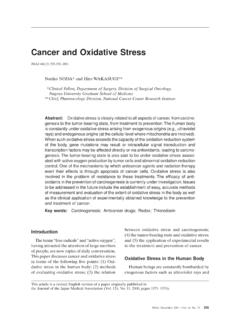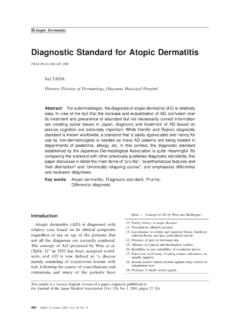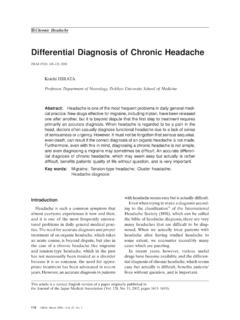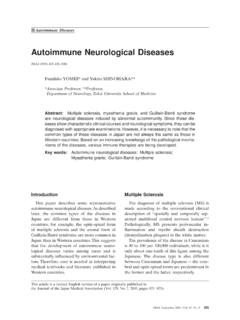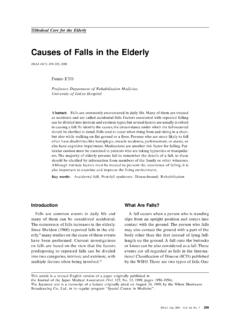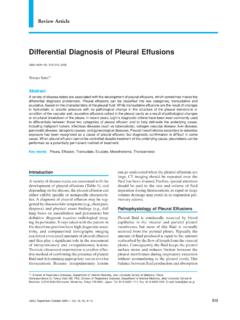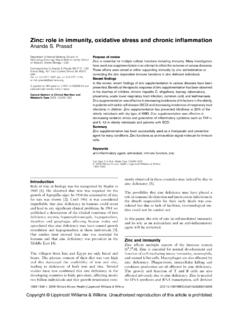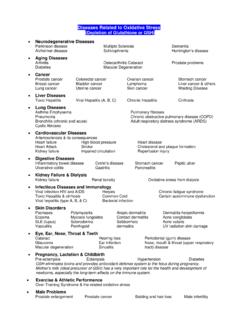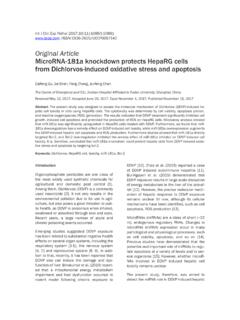Transcription of What Is Oxidative Stress? - 日本医師会
1 JMAJ, July 2002 Vol. 45, No. 7271 what Is Oxidative Stress? JMAJ 45(7): 271 276, 2002 Toshikazu YOSHIKAWA* and Yuji NAITO**Professor* and Associate Professor**, First Department of Medicine,Kyoto Prefectural University of MedicineAbstract: Oxidative stress is well known to be involved in the pathogenesis oflifestyle-related diseases, including atherosclerosis, hypertension, diabetes mellitus,ischemic diseases, and malignancies. Oxidative stress has been defined as harm-ful because oxygen free radicals attack biological molecules such as lipids, pro-teins, and DNA. However, Oxidative stress also has a useful role in physiologicadaptation and in the regulation of intracellular signal transduction. Therefore, amore useful definition of Oxidative stress may be a state where Oxidative forcesexceed the antioxidant systems due to loss of the balance between them.
2 Thebiomarkers that can be used to assess Oxidative stress in vivohave been attractinginterest because the accurate measurement of such stress is necessary for inves-tigation of its role in lifestyle diseases as well as to evaluate the efficacy of treat-ment. Many markers of Oxidative stress have been proposed, including lipid hydro-peroxides, 4-hydroxynonenal, isoprostan, 8-hydroxyguanine, and ubiquinol-10. Toprevent the development of lifestyle diseases, advice on how to lead a healthy lifeshould be given to individuals based on the levels of oxidant and antioxidant activityassessed by pertinent biomarkers. Individual genetic information should also betaken into words: Oxidative stress ; Free radicals; Active oxygen; BiomarkersIntroductionThe close association between oxidativestress and lifestyle-related diseases has becomewell known.
3 Oxidative stress is defined as a state in which oxidation exceeds the antioxi-dant systems in the body secondary to a loss ofthe balance between them. It not only causeshazardous events such as lipid peroxidationThis article is a revised English version of a paper originally published inthe Journal of the Japan Medical Association (Vol. 124, No. 11, 2000, pages 1549 1553).and Oxidative DNA damage, but also physi-ologic adaptation phenomena and regulationof intracellular signal transduction. From aclinical standpoint, if biomarkers that reflectthe extent of Oxidative stress were available,such markers would be useful for physicians togain an insight into the pathological features ofvarious diseases and assess the efficacy ofdrugs. Oxidative Stress272 JMAJ, July 2002 Vol.
4 45, No. 7 Free Radicals, Active OxygenSpecies, and Oxidative StressUsually, an atom is composed of a centralnucleus with pairs of electrons orbiting aroundit. However, some atoms and molecules haveunpaired electrons and these are called freeradicals. Free radicals are usually unstable andhighly reactive because the unpaired electronstend to form pairs with other electrons. Anoxygen molecule (O2) undergoes four-electronreduction when it is metabolized in vivo. Dur-ing this process, reactive oxygen metabolitesare generated by the excitation of electronssecondary to addition of energy or interactionwith transition elements. The reactive oxygenmetabolites thus produced are more highlyreactive than the original oxygen molecule andare called active oxygen species.
5 Superoxide,hydrogen peroxide, hydroxyl radicals, andsinglet oxygen are active oxygen species in thenarrow sense. Active oxygen species in a broadsense are listed in Table 1. Only active oxygenspecies having an unpaired electron, indicatedwith a dot above and to the right of the chemi-cal formula in the table, are free aerobic organisms, a mechanism toremove these highly reactive active oxygenspecies is essential to sustain life. Therefore,various antioxidant defense mechanisms havedeveloped in the process of evolution. It is and Y. NAITO true that the high reactivity of these oxygenmetabolites is utilized to control various bio-logical a biological viewpoint, various oxygen-derived free radicals have been attractingattention for the following reasons: Variousactive oxygen species are generated in thebody during the process of utilizing of the body is furnished with elaboratemechanisms to remove active oxygen speciesand free radicals, these by-products of oxygenmetabolism are not necessarily a threat to thebody under physiological conditions.
6 However,if active oxygen species or free radicals aregenerated excessively or at abnormal sites, thebalance between formation and removal is lost,resulting in Oxidative stress . Consequently,active oxygen species and free radicals canattack molecules in biological membranes andtissues, thus inducing various diseases. In otherwords, Oxidative stress is defined as a stateharmful to the body, which arises when oxida-tive reactions exceed antioxidant reactionsbecause the balance between them has beenlost. However, Oxidative stress is actually usefulin some instances. For example, Oxidative stressinduces apoptosis to prepare the birth canal fordelivery. Also, biological defense mechanismsare strengthened by Oxidative stress duringappropriate physical exercise and , a more useful definition of oxidativestress may be a state where oxidation exceedsthe antioxidant systems because the balancebetween them has been lost.
7 Biomarkers of Oxidative StressThe biomarkers that can be used to assessoxidative stress have been attracting interestbecause the accurate assessment of such stressis necessary for investigation of various patho-logical conditions, as well as to evaluate theefficacy of drugs. Assessment of the extent ofoxidative stress using biomarkers is interestingfrom a clinical standpoint. The markers foundTable 1 Major Active Oxygen SpeciesO2 Superoxide radicalH2O2 Hydrogen peroxideHO Hydroxyl radical1O2 Singlet oxygenHOO Hydroperoxyl radicalLOOHA lkylhydroperoxideLOO Alkylperoxyl radicalLO Alkoxyl radicalCIO Hypochlorite ionFe4 OFerryl ionFe5 OPeriferryl ionNO Nitric oxideJMAJ, July 2002 Vol. 45, No. 7273 Oxidative stress been the most frequently used marker of oxi-dative stress partly because lipid peroxidation(Fig.)
8 1) is a very important mechanism of cellmembrane destruction. Lipid peroxidation is achain reaction by which unsaturated fatty acids(cell membrane components) are oxidized invarious pathological a hydrogen atom is removed from afatty acid molecule for some reason, the freeradical chain reaction proceeds as shown inFig. 1. Thus, radicals that can be involved inthe extraction of hydrogen atoms from lipidsinclude the hydroxyl radical (HO ), the hydro-peroxyl radical (HOO ), the lipid peroxyl radi-cal (LOO ), and the alkoxyl radical (LO ).Metal-oxygen complexes, particularly iron-oxygen complexes, are also important in peroxidation chain reaction propagatesitself once it has started. The process by whichlipid radicals (L ) are generated from lipids(LH) is called the chain initiation radicals (L ) thus generated react imme-diately with oxygen, resulting in the formationof LOO , which attacks another lipid andremoves a hydrogen atom from it, resulting inthe formation of lipid hydroperoxide (lipid per-oxide; LOOH) and another L.
9 This new L alsoreacts with oxygen and forms LOO , whichattacks another lipid to generate lipid peroxide,so lipid peroxide accumulates as the chain reac-tion mucosal injury occurs in patientswith extensive burns. Before the developmentof mucosal lesions, the blood level of skin-derived substances that react with thiobarbi-turic acid shows an increase. Then these sub-stances also increase in the gastric mucosa,leading to the development of mucosal free radical peroxidation of lipids is animportant factor in local injury to cell mem-branes and impairment of the activity ofenzymes and receptors bound to the mem-brane, and the lipid peroxide thus producedcan affect even remote the agents that protect the bodyfrom lipid peroxidation, vitamin E is consid-in blood, urine, and other biological fluids mayprovide information of diagnostic value, but itwould be ideal if organs and tissues sufferingfrom Oxidative stress could be imaged in a man-ner similar to CT scanning and MR imaging.
10 Inrecent years, attempts have been made to useelectron spin resonance techniques for this pur-pose, but it will take time before such methodscan be applied to the body is not necessarily fullyprotected against Oxidative damage, some ofits constituents may be injured by free radicals,and the resultant Oxidative products haveusually been used as markers. Many markershave been proposed, including lipid peroxides,malondialdehyde, and 4-hydroxynonenal asmarkers for Oxidative damage to lipids; iso-prostan as a product of the free radical oxi-dation of arachidonic acid; 8-oxoguanine(8-hydroxyguanine) and thymineglycol as indi-cators of Oxidative damage to DNA; and vari-ous products of the oxidation of protein andamino acids including carbonyl protein,hydroxyleucine, hydrovaline, and nitrotyro-sine.
